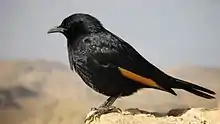Tristram's starling
Tristram's starling (Onychognathus tristramii) or Tristram's grackle, is a species of starling native to the Middle East. Its territory is in the areas of Israel, Jordan, northeastern Egypt (Sinai Peninsula), western Saudi Arabia, Yemen, and Oman, nesting mainly on rocky cliff faces.[2] The species is named after Reverend Henry Baker Tristram, who also collected natural history specimens.[3]
| Tristram's starling | |
|---|---|
 | |
| at Masada, Israel | |
| Scientific classification | |
| Kingdom: | Animalia |
| Phylum: | Chordata |
| Class: | Aves |
| Order: | Passeriformes |
| Family: | Sturnidae |
| Genus: | Onychognathus |
| Species: | O. tristramii |
| Binomial name | |
| Onychognathus tristramii (Sclater, 1858) | |
Description
A member of the genus Onychognathus, it is 25 cm long (including a 9 cm tail), with a wingspan of 44–45 cm, and a weight of 100–140 g. The males have glossy iridescent black plumage with orange patches on the outer wing, which are particularly noticeable in flight. The bill and legs are black. Females and young birds are similar but duller and with a greyish head, lacking the plumage gloss.[2][4]
Behavior
It is gregarious and noisy, with a call that resembles a wolf whistle. They are omnivorous, feeding on fruit and invertebrates, and can also be observed grooming Nubian ibex and domestic livestock for parasites. They are becoming increasingly commensal with man, feeding in towns and villages; this has enabled a recent northward spread in their distribution.[2]
Gallery
 Female in Israel
Female in Israel Tristram observation Masada in Israel
Tristram observation Masada in Israel Tristram on a Nubian ibex in Sde Boker, Israel
Tristram on a Nubian ibex in Sde Boker, Israel Oman
Oman
References
- BirdLife International (2012). "Onychognathus tristramii". IUCN Red List of Threatened Species. 2012. Retrieved 26 November 2013.CS1 maint: ref=harv (link)
- Snow, D. W. & Perrins, C. M. (1998). The Birds of the Western Palearctic Concise Edition. OUP ISBN 0-19-854099-X.
- Beolens, Bo; Watkins, Michael (2003). Whose Bird? Men and Women Commemorated in the Common Names of Birds. London: Christopher Helm. pp. 342–343.
- Mullarney, K., Svensson, L., Zetterström, D., & Grant, P. J. (1999). Collins Bird Guide. Harper Collins, London. ISBN 0-00-219728-6.
